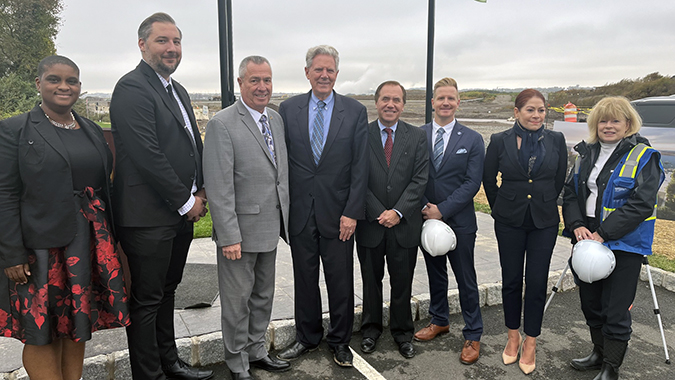The state Department of Environmental Protection announced the relaunch this week of the successful Brownfield Development Area program that helps communities design and implement comprehensive remediation and redevelopment programs for contaminated properties.
Municipalities are urged to apply by April 30, 2024, to designate abandoned and blighted properties in their communities as a Brownfield Development Area (BDA). A BDA designation kickstarts a coordinated effort through DEP to advance the investigation, remediation and redevelopment of brownfield sites.
DEP Commissioner Shawn LaTourette, Rep. Frank Pallone (D-NJ), Assembly Speaker Craig Coughlin (D-18) and other government leaders used the state’s largest and most complex redevelopment project as a backdrop for the announcement on Oct. 30. The location is the former National Lead operations site, which was once contaminated with heavy metals, polychlorinated biphenyls (PCBs), radiological contaminants and other pollutants.
The U.S. Environmental Protection Agency provided technical guidance on removal of PCBs from two Superfund sites on the property. Remediation work at the 418-acre site is now nearly complete after 15 years, and construction is anticipated to begin in spring 2024 to transform the property into a $2.5 billion mixed-use redevelopment project known as Riverton.
The former National Lead site, part of the Sayreville Waterfront BDA, has been a more than $120 million remediation effort, including $20 million in Hazardous Discharge Site Remediation Funds (HDSRF) that helped leverage $100 million in private sector funding. The project developer has also applied to the New Jersey Economic Development Authority (NJEDA) for grant funds.
The future Riverton waterfront redevelopment is anticipated to create a 6.5 million-square-foot mixed-use development with about 1.3 million square feet of retail and entertainment space, 2 million square feet of office and other commercial space and about 2,000 residential units, which includes 300 affordable housing units.
“Relaunching of the BDA program is a renewal of DEP’s commitment to the redevelopment of brownfield sites that place a tremendous economic, environmental and public health burden on municipalities,” Commissioner LaTourette said. “The BDA program is designed to encourage investment and to bring these properties back to their full potential.”
Under the BDA program, municipalities and redevelopment authorities are eligible for up to $5 million annually in Hazardous Discharge Site Remediation Fund (HDSRF) grants, including remedial action matching grants providing up to 75% of the remedial action costs for all site end uses. Selected BDAs are provided with a single point of contact at DEP, who works closely with municipal officials, stakeholders, developers and Licensed Site Remediation Professionals (LSRPs) to coordinate investigation, remediation and redevelopment plans.
Since its inception in 2003, the BDA program has provided nearly $200 million in HDSRF grants to 31 municipalities. The BDA program helped create hundreds of acres of new open space, recreation and waterfront access to underserved communities including Camden, Elizabeth, Newark, Paterson, Jersey City, Perth Amboy and Trenton.
Repurposing of blighted brownfield sites have also resulted in thousands of new housing units within new mixed-use developments and transit-oriented developments areas in municipalities including Harrison, Orange, West Orange, Woodbridge, Rahway, Carteret, Haddon Township, Bayonne, Plainfield and Palmyra. Climate adaptation and resiliency elements have been placed in, or are planned for BDAs in Jersey City, Bayonne, Camden, Perth Amboy, Trenton and Sayreville BDA’s Riverton development.
– Photo Credit: Office of Rep. Frank Pallone Jr. –

